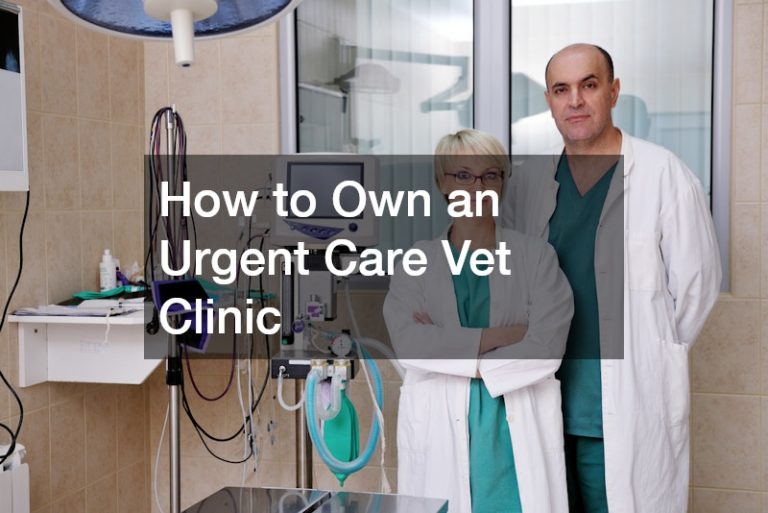Opening a veterinary urgent care clinic is a substantial undertaking that requires a deep understanding of both veterinary medicine and business management. This guide explores the essential steps and considerations for those aspiring to own and operate an urgent care vet clinic. By addressing common questions and challenges, you will be better prepared to embark on this rewarding journey.
What are the Initial Steps to Start a Vet Urgent Care Clinic?
Research and Planning
Understanding the market demand, local regulations, and required certifications is critical. Begin by conducting thorough market research to determine if there is a viable need for urgent care veterinary services in your area.
Use this information to craft a strategic business plan that outlines your vision, mission, and the services you plan to offer. Tailor this plan to your specific location and target clientele, seeking feedback from seasoned professionals.
One key aspect to consider during planning is the selection of a reputable software system to manage your clinic’s operations. A comprehensive plan will include financial projections, marketing strategies, and an operational blueprint.
Securing Financing and Location
Explore various financing options to fund your clinic, such as bank loans, investors, or personal savings. Determine how much capital is necessary to start and sustain the clinic during its early stages.
Choosing the right location involves considering factors like accessibility and visibility, which can impact client volume. Research local demographics and competition to ensure your clinic meets an unmet need in the community.
When securing a location, also examine the physical space requirements and potential for future growth. A strategically placed clinic can serve as a cornerstone for building a profitable practice.
What Legal and Regulatory Requirements Must Be Met?
Licensing and Certification
Ensure compliance with all local and national veterinary practice laws. Obtain necessary licenses both for the clinic and individual veterinarians to uphold professional standards.
This typically includes state veterinary board certifications and specific permits related to animal care and handling. Non-compliance can result in severe penalties, so it’s vital to adhere to these regulations from the onset.
Engage legal counsel or compliance experts to stay informed about ongoing regulatory changes. Proper licensing and certification will also establish trust with clients and partners.
Health and Safety Standards
You must adhere to strict health and safety guidelines to protect staff, patients, and clients. These regulations are designed to ensure the welfare of animals and the safety of the people who care for them.
Regular inspection and maintenance of equipment, along with staff training in emergency protocols, are essential components of a safe practice. Compliance helps avoid legal liabilities and fosters a safe environment.
Consider investing in robust insurance policies to further mitigate potential risks. This proactive approach to health and safety will enhance your clinic’s reputation and operational efficiency.
How to Assemble the Right Veterinary Team?
Finding Qualified Staff
Hire skilled veterinarians, technicians, and support staff with experience in urgent care to provide high standards of animal care. Look for candidates who demonstrate both technical expertise and a compassionate approach to patient care.
Advertise job openings through veterinary networks, industry events, and online platforms. Be clear about job expectations, performance criteria, and opportunities for career advancement to attract top talent.
Assemble a diverse team that can bring various perspectives and solutions to the practice. Implement a thorough hiring process that includes background checks and skills assessments.
Training and Development
Implement ongoing professional development opportunities and create a cohesive team environment through training programs. This contributes to staff retention and job satisfaction, as well as improved patient care.
Continuously update your team’s skills to keep pace with advances in veterinary medicine and technology. Encourage staff to participate in industry conferences and workshops.
Create a culture of continuous feedback and improvement within your clinic. This focus on development ensures that your staff remains engaged and motivated.
How to Equip and Manage the Facility Efficiently?
Choosing the Right Equipment
Invest in modern diagnostic and treatment equipment to meet the demands of an urgent care setting. Choose reliable and innovative technologies that improve the accuracy and efficiency of your services.
Stay informed about advancements in veterinary tools and consider leasing options for high-cost items. Efficient equipment procurement will support a streamlined workflow and enhance patient care.
Regularly evaluate the performance and condition of your clinic’s equipment to ensure it meets the required standards. This vigilance will contribute to a safe and effective practice.
Implementing Operational Protocols
Develop operational protocols to manage patient flow and ensure consistent quality of service. Establish clear guidelines for handling emergencies to maintain effective and rapid responses.
Standardizing procedures helps your staff deliver uniform care, regardless of the individual handling a case. Moreover, this consistency builds client trust and clinic credibility.
Periodic reviews and updates of your protocols will keep them relevant and aligned with emerging industry standards. Keep communication lines open for staff suggestions to improve these standards.
What Strategies Foster Client Satisfaction and Business Growth?
Client Communication and Follow-Up
Enhance client experience through clear communication, timely follow-ups, and delivering compassionate care. Engage clients with personalized attention and transparency regarding their pet’s treatment plans.
Implement systems for appointment reminders and post-visit check-ins to strengthen client relationships. This proactive approach will encourage client return and referrals.
Utilize surveys and feedback mechanisms to gauge satisfaction levels and identify areas for improvement. Building strong client relationships is key to long-term business success.
Marketing and Community Engagement
Adopt marketing strategies to create awareness and engage with the community, building a loyal client base. Utilize social media, community events, and partnerships with local organizations to promote your clinic’s services.
Your clinic’s online presence is also vital in attracting new clients. Ensure your website is user-friendly and provides valuable information about your services and team.
Consider hosting educational workshops or open days to establish your clinic as a community resource. These efforts not only drive growth but also foster goodwill and advocacy for animal health.





